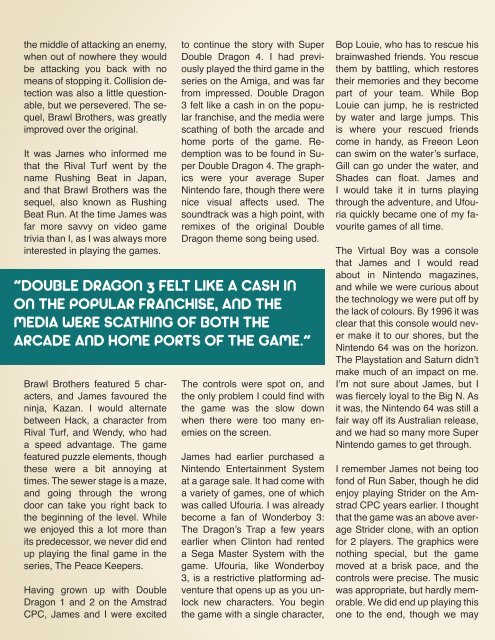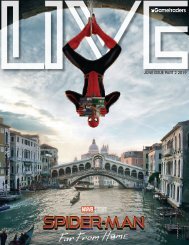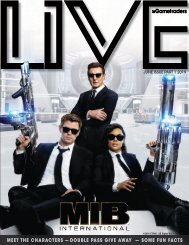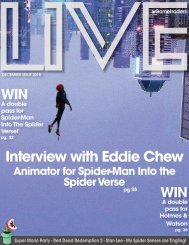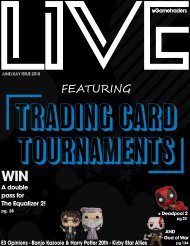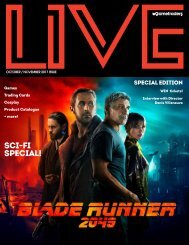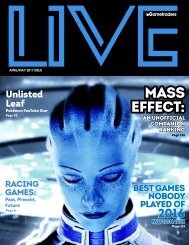Retro Live 2017 - issue 2
Readers voted for the video game System of the Century - pre 2000 ... choices included consoles and computers. Plus we look at Flight Sims and much more.
Readers voted for the video game System of the Century - pre 2000 ... choices included consoles and computers. Plus we look at Flight Sims and much more.
Create successful ePaper yourself
Turn your PDF publications into a flip-book with our unique Google optimized e-Paper software.
the middle of attacking an enemy,<br />
when out of nowhere they would<br />
be attacking you back with no<br />
means of stopping it. Collision detection<br />
was also a little questionable,<br />
but we persevered. The sequel,<br />
Brawl Brothers, was greatly<br />
improved over the original.<br />
It was James who informed me<br />
that the Rival Turf went by the<br />
name Rushing Beat in Japan,<br />
and that Brawl Brothers was the<br />
sequel, also known as Rushing<br />
Beat Run. At the time James was<br />
far more savvy on video game<br />
trivia than I, as I was always more<br />
interested in playing the games.<br />
Brawl Brothers featured 5 characters,<br />
and James favoured the<br />
ninja, Kazan. I would alternate<br />
between Hack, a character from<br />
Rival Turf, and Wendy, who had<br />
a speed advantage. The game<br />
featured puzzle elements, though<br />
these were a bit annoying at<br />
times. The sewer stage is a maze,<br />
and going through the wrong<br />
door can take you right back to<br />
the beginning of the level. While<br />
we enjoyed this a lot more than<br />
its predecessor, we never did end<br />
up playing the final game in the<br />
series, The Peace Keepers.<br />
Having grown up with Double<br />
Dragon 1 and 2 on the Amstrad<br />
CPC, James and I were excited<br />
to continue the story with Super<br />
Double Dragon 4. I had previously<br />
played the third game in the<br />
series on the Amiga, and was far<br />
from impressed. Double Dragon<br />
3 felt like a cash in on the popular<br />
franchise, and the media were<br />
scathing of both the arcade and<br />
home ports of the game. Redemption<br />
was to be found in Super<br />
Double Dragon 4. The graphics<br />
were your average Super<br />
Nintendo fare, though there were<br />
nice visual affects used. The<br />
soundtrack was a high point, with<br />
remixes of the original Double<br />
Dragon theme song being used.<br />
”DOUBLE DRAGON 3 FELT LIKE A CASH IN<br />
ON THE POPULAR FRANCHISE, AND THE<br />
MEDIA WERE SCATHING OF BOTH THE<br />
ARCADE AND HOME PORTS OF THE GAME.”<br />
The controls were spot on, and<br />
the only problem I could find with<br />
the game was the slow down<br />
when there were too many enemies<br />
on the screen.<br />
James had earlier purchased a<br />
Nintendo Entertainment System<br />
at a garage sale. It had come with<br />
a variety of games, one of which<br />
was called Ufouria. I was already<br />
become a fan of Wonderboy 3:<br />
The Dragon’s Trap a few years<br />
earlier when Clinton had rented<br />
a Sega Master System with the<br />
game. Ufouria, like Wonderboy<br />
3, is a restrictive platforming adventure<br />
that opens up as you unlock<br />
new characters. You begin<br />
the game with a single character,<br />
Bop Louie, who has to rescue his<br />
brainwashed friends. You rescue<br />
them by battling, which restores<br />
their memories and they become<br />
part of your team. While Bop<br />
Louie can jump, he is restricted<br />
by water and large jumps. This<br />
is where your rescued friends<br />
come in handy, as Freeon Leon<br />
can swim on the water’s surface,<br />
Gill can go under the water, and<br />
Shades can float. James and<br />
I would take it in turns playing<br />
through the adventure, and Ufouria<br />
quickly became one of my favourite<br />
games of all time.<br />
The Virtual Boy was a console<br />
that James and I would read<br />
about in Nintendo magazines,<br />
and while we were curious about<br />
the technology we were put off by<br />
the lack of colours. By 1996 it was<br />
clear that this console would never<br />
make it to our shores, but the<br />
Nintendo 64 was on the horizon.<br />
The Playstation and Saturn didn’t<br />
make much of an impact on me.<br />
I’m not sure about James, but I<br />
was fiercely loyal to the Big N. As<br />
it was, the Nintendo 64 was still a<br />
fair way off its Australian release,<br />
and we had so many more Super<br />
Nintendo games to get through.<br />
I remember James not being too<br />
fond of Run Saber, though he did<br />
enjoy playing Strider on the Amstrad<br />
CPC years earlier. I thought<br />
that the game was an above average<br />
Strider clone, with an option<br />
for 2 players. The graphics were<br />
nothing special, but the game<br />
moved at a brisk pace, and the<br />
controls were precise. The music<br />
was appropriate, but hardly memorable.<br />
We did end up playing this<br />
one to the end, though we may


